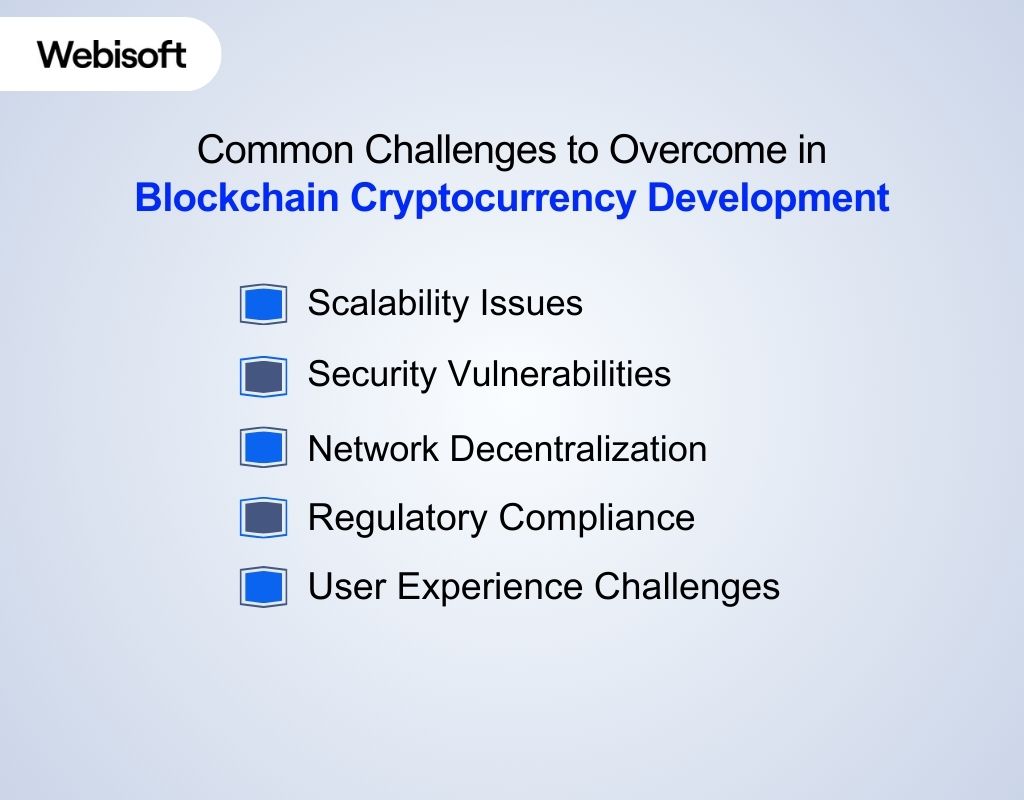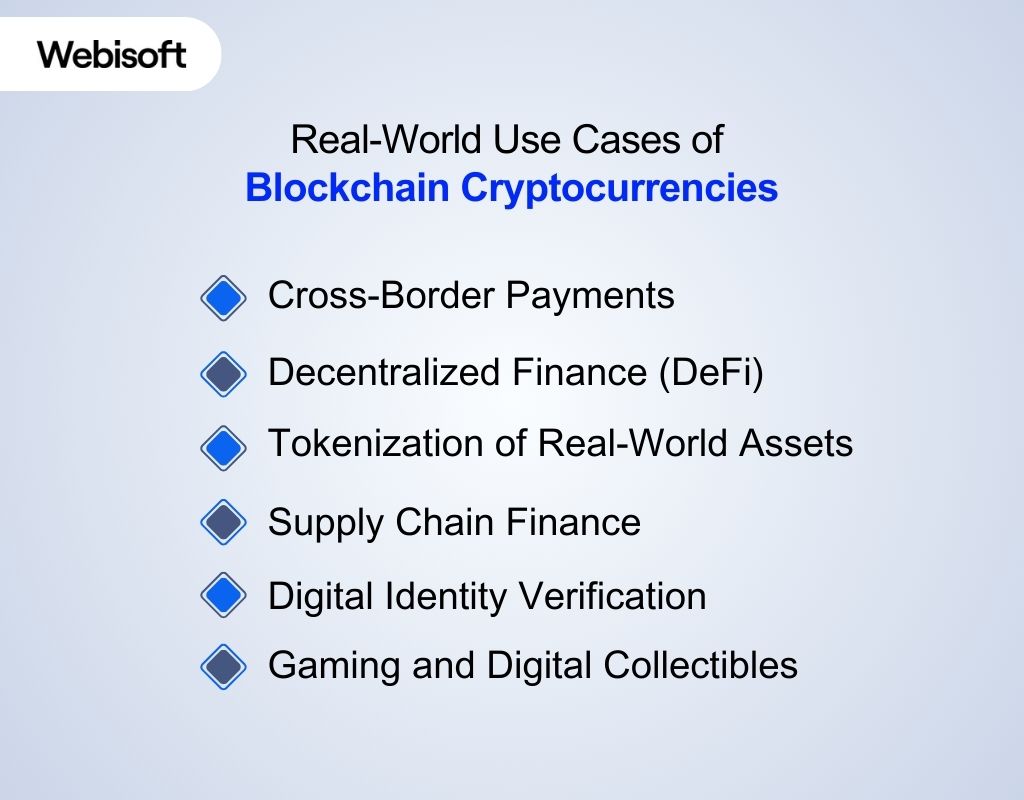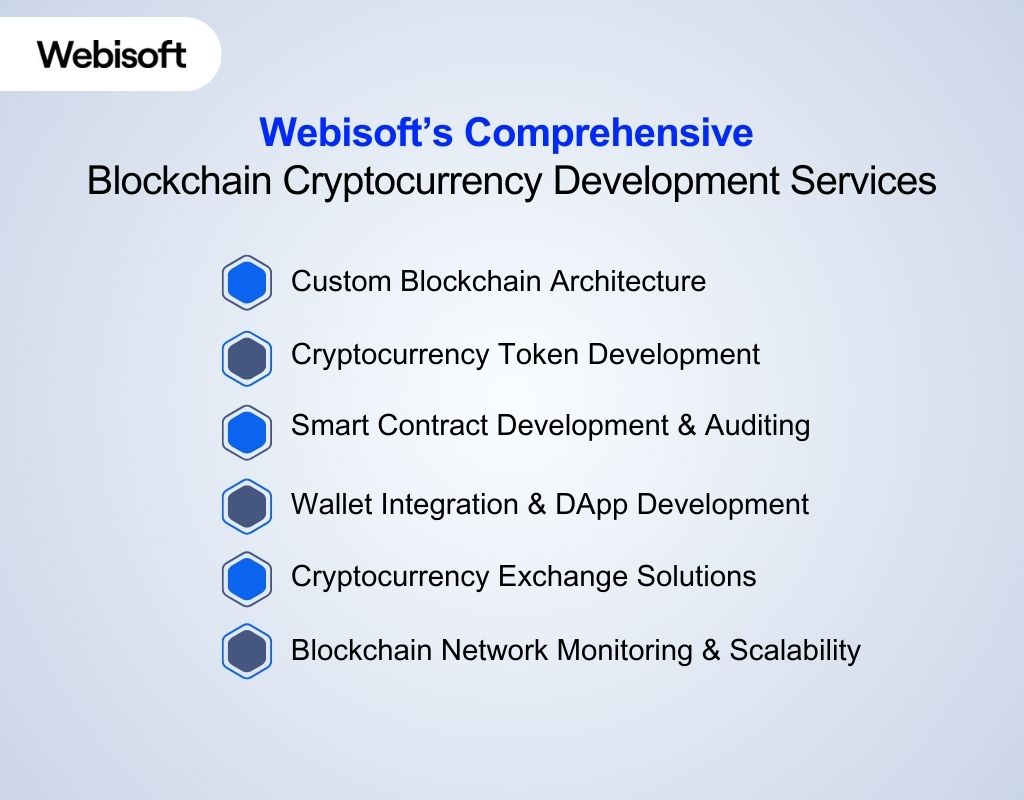How To Create A Blockchain Cryptocurrency: Expert Guide 2025
- BLOG
- Cryptocurrency Development
- October 12, 2025
The blockchain industry is constantly growing, expected to nearly double from about $29 billion in 2024 to over $49 billion in 2025. This decentralized and distributed digital ledger system is changing how we handle money, track products, and prove ownership online. Now, creating blockchain cryptocurrency is a great way to be part of this exciting change and build something new in the digital world. But how to create a blockchain cryptocurrency? To create a blockchain cryptocurrency, define your purpose, choose a blockchain platform or create one, develop the code or token, and establish consensus rules. Finally, deploy your currency on the network. Keep on reading to have a detailed overview with an easy-to-follow guide on making blockchain cryptocurrency.
Contents
- 1 How To Create A Blockchain Cryptocurrency: A Step by Step Guide
- 1.1 Step 1: Define Blockchain Specifications and Consensus Mechanism
- 1.2 Step 2: Set Up Development Environment and Tools
- 1.3 Step 3: Develop Blockchain Core and Network Layer
- 1.4 Step 4: Implement Consensus Algorithm and Security Features
- 1.5 Step 5: Create Cryptocurrency Token Logic
- 1.6 Step 6: Test on a Private/Test Network
- 1.7 Step 7: Launch Mainnet and Distribute Cryptocurrency
- 1.8 Step 8: Maintain, Monitor, and Upgrade
- 2 Let’s build the future of finance together.
- 3 Common Challenges to Overcome in Blockchain Cryptocurrency Development
- 4 Real-World Use Cases of Blockchain Cryptocurrencies
- 5 Webisoft’s Comprehensive Blockchain Cryptocurrency Development Services
- 6 Let’s build the future of finance together.
- 7 In Closing
- 8 Frequently Asked Questions
How To Create A Blockchain Cryptocurrency: A Step by Step Guide
 Creating a blockchain cryptocurrency involves several key steps, starting from choosing a platform to coding and launching your coin. Here’s a simple guide to get you started.
Creating a blockchain cryptocurrency involves several key steps, starting from choosing a platform to coding and launching your coin. Here’s a simple guide to get you started.
Step 1: Define Blockchain Specifications and Consensus Mechanism
You need to start by defining the blockchain’s key features before coding. For this, check and fix whether the blockchain will be public or private. Then, choose a consensus mechanism to validate transactions. You can choose anywhere from Proof of Work (PoW) and Proof of Stake (PoS). PoW requires solving complex puzzles, whereas PoS selects validators based on their stake. Next, set parameters like block size, block time, and transaction fees. These affect speed and scalability. After that, design the token supply and distribution rules. Next, you need to plan how nodes will communicate and maintain the ledger. Use cryptographic hashes to link blocks securely.
Step 2: Set Up Development Environment and Tools
After defining your blockchain’s specifications and consensus mechanism, establish a solid development environment. This setup supports efficient coding, testing, and team collaboration throughout the project.
i) Choose Your Programming Language
Select a language based on performance needs, ecosystem support, and your team’s skills:
- C++: High performance and resource control are used in Bitcoin Core.
- Go: Excellent for concurrency and networking, and used in Ethereum’s Geth and Hyperledger Fabric.
- Rust: Memory-safe and fast, and popular for projects like Solana and Polkadot.
- Python / JavaScript: Suitable for prototyping and building tools or SDKs.
ii) Select Frameworks and Libraries
Once you’ve selected your programming language, make use of existing frameworks and libraries to accelerate development and minimize complexity. Look to established reference clients such as Bitcoin Core and Ethereum clients for guidance and inspiration. Consider using tools like:
- Substrate – A modular Rust framework for building customizable blockchains.
- Libp2p – A flexible peer-to-peer networking library, ideal for decentralized systems.
- Cryptographic libraries such as OpenSSL or libsodium – Essential for implementing secure hashing, digital signatures, and encryption.
iii) Configure Development Tools and IDEs
To streamline development, set up tools tailored to your chosen language and frameworks. Choose:
- IDEs like Visual Studio Code, JetBrains CLion, or GoLand, depending on your language.
- Linters and static analysis tools to catch bugs early.
- Version control using Git with repositories on GitHub, GitLab, or Bitbucket for collaboration.
iv) Establish Build and Deployment Pipelines
Finally, automate your build, test, and deployment processes to maintain code quality and speed up delivery.
- Use Jenkins, GitHub Actions, or GitLab CI for continuous integration workflows.
- Containerize blockchain nodes with Docker for consistent deployment environments
Step 3: Develop Blockchain Core and Network Layer
The next step in learning how to create a blockchain cryptocurrency is to build the blockchain core and network layer. This means creating the main parts that handle how data is stored, how transactions are checked, and how nodes talk to each other. Start by designing the blockchain architecture, where blocks are securely linked using cryptographic hashes. Define how transactions are validated, processed, and added to the chain. Then, focus on the peer-to-peer (P2P) network layer so nodes can find each other, share transactions, and broadcast new blocks safely. Set up different node types like full nodes, light nodes, or validators depending on your consensus method. Make sure the ledger is copied across many nodes to avoid any single point of failure.
Step 4: Implement Consensus Algorithm and Security Features
Consensus algorithms form the backbone of any blockchain network. Once you’ve defined your blockchain’s specifications and selected a consensus mechanism, it’s essential to implement it with precision and strong security practices to ensure the network remains secure, reliable, and efficient. Consensus enables all nodes in the network to agree on the validity of transactions and the addition of new blocks, helping to prevent fraud, double spending, and other inconsistencies.
| Consensus Algorithm | How It Works |
| Proof of Work (PoW) | Miners solve cryptographic puzzles to add blocks |
| Proof of Stake (PoS) | Validators are chosen based on the amount of cryptocurrency they hold and “stake.” |
| Delegated Proof of Stake (DPoS) | Token holders vote for a limited number of delegates to validate transactions |
| Practical Byzantine Fault Tolerance (PBFT) | Nodes agree through rounds of voting, tolerate faulty nodes up to a limit |
| Proof of Authority (PoA) | Trusted nodes (authorities) validate transactions |
Even the most robust consensus algorithms can be undermined without strong security measures, potentially exposing the entire network to critical vulnerabilities. To protect your blockchain:
- Use cryptographic hashing to guarantee block immutability.
- Apply digital signatures to verify the authenticity of transactions.
- Encrypt data both in transit and at rest to safeguard user privacy.
- Defend against Sybil attacks through mechanisms like staking or identity verification.
- Secure network communication using TLS/SSL and reliable peer-to-peer protocols.
Step 5: Create Cryptocurrency Token Logic
Developing the token logic is a critical step in building your blockchain-based cryptocurrency. Begin by clearly defining the token’s purpose, whether it’s a currency, utility token, governance token, or another type. Next, select the appropriate blockchain platform for your token, such as Ethereum (ERC-20), Binance Smart Chain (BEP-20), or Solana. Your choice should consider factors like transaction speed, network fees, and ecosystem compatibility. Then, develop the smart contract that controls your token’s behavior. Take advantage of Webisoft’s expert smart contract development services. This contract defines essential attributes such as the token name, symbol, total supply, and decimal precision. You may also incorporate additional features like minting, burning, or transaction fees based on your tokenomics model. Adhering to established token standards, such as ERC-20 for fungible tokens, ensures broad compatibility with wallets, exchanges, and other blockchain infrastructure.
Step 6: Test on a Private/Test Network
After creating your cryptocurrency token logic, the next critical step is to test it thoroughly on a private or test network. Testing in this controlled environment helps you verify that your token functions correctly without risking real assets. Utilize the testnets like Ethereum’s Goerli or Rinkeby to simulate real blockchain conditions that help you to deploy and interact with your smart contracts safely. During testing, focus on core functions such as token transfers, minting, burning, and interactions with other smart contracts. It’s also important to perform stress testing by simulating high transaction volumes to check how your token handles load and to identify potential bottlenecks.
Step 7: Launch Mainnet and Distribute Cryptocurrency
Once your token is fully tested on a test network, it’s time to launch on the mainnet and distribute your cryptocurrency. Before you hit deploy, make sure your wallet has enough of the blockchain’s native cryptocurrency to cover gas fees. This is what powers the transaction. Next, choose a deployment tool you’re comfortable with: Hardhat, Truffle, or even Remix if you prefer working in the browser. These tools will help you package up your smart contract’s bytecode and any setup parameters, then send it off to the mainnet. Once it’s deployed, your contract is live, and your token or dApp is officially part of the blockchain!
Step 8: Maintain, Monitor, and Upgrade
Maintaining, monitoring, and upgrading your blockchain network is vital for its long-term success and security. After launching, continuous attention ensures smooth performance, protects against threats, and adapts to evolving needs. Helpful Tips for Maintenance:
- Regular Monitoring: Use monitoring tools to keep an eye on network health, transaction speeds, and node uptime. Set up alerts to catch anything unusual before it becomes a bigger issue.
- Security Audits: Don’t wait for something to go wrong. Schedule regular audits and penetration tests to find and fix vulnerabilities early. Bring in third-party experts for objective, high-quality reviews.
- Backup and Recovery: Things can go wrong, so be ready. Set up reliable backups and have a disaster recovery plan in place to minimize downtime and data loss.
- Upgrade Protocols: When it’s time to roll out updates, test everything thoroughly. Smart contracts should be upgradeable when possible to allow improvements without disrupting the network.
- Access Controls: Protect your infrastructure by enforcing strict role-based access and enabling multi-factor authentication, especially for keys and admin operations.
Let’s build the future of finance together.
Contact Webisoft today to get started on your blockchain project.
Common Challenges to Overcome in Blockchain Cryptocurrency Development
 When exploring how to create a blockchain cryptocurrency, it’s important to understand the common challenges involved and how to address them to ensure a successful and sustainable project.
When exploring how to create a blockchain cryptocurrency, it’s important to understand the common challenges involved and how to address them to ensure a successful and sustainable project.
1. Scalability Issues
As more users join the network, the blockchain can start to feel the strain, leading to slower transaction times and higher fees. This happens because each block has a fixed size and a set time interval for creation, which limits how many transactions can be processed at once. Solution: To address this, you can explore scalability techniques like layer-2 protocols, sharding, or optimizing your consensus mechanism. While increasing block size or reducing block time might help, be mindful—these changes can come at the cost of decentralization.
2. Security Vulnerabilities
Blockchain systems face risks like 51% attacks, double spending, or bugs in smart contracts and consensus code. Weak cryptographic implementations can also expose the network to exploits. Solution: Employ thorough security audits, use well-established cryptographic libraries, and test extensively on testnets. Implement formal verification for smart contracts when possible.
3. Network Decentralization
If a small group of nodes or validators controls a majority of the network, it risks censorship, manipulation, and loss of trust. Concentration of power defeats the core principle of decentralization. Solution: Choose consensus algorithms that are specifically designed to prevent stake or power from becoming too concentrated. Additionally, promote geographic and infrastructural diversity among nodes to help maintain a truly decentralized network.
4. Regulatory Compliance
Cryptocurrency projects often operate in uncertain and rapidly evolving legal environments. Without proper attention to regulations, they risk facing penalties or even being shut down. Legal requirements can vary significantly depending on the jurisdiction and the type of token involved. Solution: Involve legal experts from the start. Where applicable, implement Know Your Customer (KYC) and Anti-Money Laundering (AML) protocols. Also, design your tokenomics to align with existing regulations, helping ensure long-term compliance and stability.
5. User Experience Challenges
Complicated interfaces, confusing wallet setups, and slow transaction times can quickly frustrate users, making it harder to grow your network and attract mainstream adoption. In the world of crypto, usability is key to scaling successfully. Solution: Focus on creating intuitive wallets and clean, user-friendly interfaces. Improve transaction speed wherever possible, and support users with clear education, guidance, and responsive help channels.
Real-World Use Cases of Blockchain Cryptocurrencies
 Blockchain cryptocurrencies have evolved into powerful tools driving innovation across multiple industries. Here are some detailed real-world use cases demonstrating their impact in 2025:
Blockchain cryptocurrencies have evolved into powerful tools driving innovation across multiple industries. Here are some detailed real-world use cases demonstrating their impact in 2025:
1. Cross-Border Payments
If you’re dealing with international payments, cryptocurrencies can help you avoid high fees and long wait times. By removing intermediaries like banks, you get faster, cheaper transfers. For example, Ripple’s XRP Ledger works with major banks to move money across borders more efficiently, benefiting both businesses and individuals.
2. Decentralized Finance (DeFi)
Want to borrow, lend, or trade without going through a traditional bank? DeFi makes that possible. Platforms like Aave and Compound give you direct control over your finances, often with lower fees and greater transparency. This opens access to financial services for people who’ve traditionally been excluded.
3. Tokenization of Real-World Assets
Next, consider how you might invest in real estate or art. Through tokenization, blockchain lets you own a fraction of high-value assets. Platforms like RealT make it easy to buy digital shares of physical properties, helping you diversify your portfolio with lower upfront investment.
4. Supply Chain Finance
If your business relies on supply chains, blockchain can bring more trust and visibility to the process. By recording transactions immutably, platforms like TradeIX help you reduce fraud. It tracks goods more easily and optimizes financing, making your operations smoother and more secure.
5. Digital Identity Verification
Managing your digital identity can be a hassle. Blockchain solutions like SelfKey allow you to securely control your personal data while streamlining verification processes. Whether you’re accessing financial services or government programs, you stay in charge of your information.
6. Gaming and Digital Collectibles
Finally, if you’re into gaming or digital art, blockchain opens up exciting possibilities. With platforms like Enjin, you can truly own in-game items or NFTs, trade them freely, and even earn money. This gives players and creators more power and new ways to engage with digital content.
Webisoft’s Comprehensive Blockchain Cryptocurrency Development Services
 In the fast-paced world of blockchain cryptocurrency, Webisoft offers full-cycle development services to meet the specific demands of digital currency platforms. Here’s how Webisoft supports blockchain cryptocurrency development:
In the fast-paced world of blockchain cryptocurrency, Webisoft offers full-cycle development services to meet the specific demands of digital currency platforms. Here’s how Webisoft supports blockchain cryptocurrency development:
- Custom Blockchain Architecture: Webisoft creates blockchain systems specifically designed for cryptocurrency operations. This architecture ensures a scalable, secure foundation for digital currency transactions.
- Cryptocurrency Token Development: Webisoft specializes in creating custom tokens based on ERC-20, ERC-721, and other standards. These tokens are designed for secure and efficient transactions.
- Smart Contract Development & Auditing: Secure and optimized smart contracts are built for cryptocurrency systems. It helps to manage transactions, token transfers, and automated processes.
- Wallet Integration & DApp Development: Webisoft provides seamless integration of Web3-compatible wallets with your cryptocurrency platforms. The users can interact securely with tokens and decentralized applications (DApps) in real-time.
- Cryptocurrency Exchange Solutions: Webisoft delivers customized solutions for cryptocurrency exchanges. It offers secure and efficient peer-to-peer transactions.
- Blockchain Network Monitoring & Scalability: Webisoft guarantees that cryptocurrency platforms are continuously monitored and optimized for performance.
Let’s build the future of finance together.
Contact Webisoft today to get started on your blockchain project.
In Closing
Understanding how to create a blockchain cryptocurrency opens up exciting opportunities to innovate in the digital world. While the process involves technical steps and challenges, the rewards of building a secure, transparent, and decentralized digital asset are well worth the effort. If you’re a developer, entrepreneur, or enthusiast, taking the time to learn and apply these fundamentals can set you on the path to success.
Frequently Asked Questions
What’s the difference between a coin and a token?
A coin operates on its own blockchain (like Bitcoin), while a token runs on an existing blockchain (like an ERC-20 token on Ethereum).
How much does it cost to create a cryptocurrency?
Costs vary widely depending on complexity, development time, and legal requirements, ranging from a few thousand to hundreds of thousands of dollars.
Is creating a cryptocurrency legal?
Cryptocurrency legality depends on your country’s regulations. It’s important to research local laws and possibly consult legal experts before launching.
How do I ensure my cryptocurrency is secure?
Security involves thorough code audits, using tested cryptographic libraries, and implementing strong consensus mechanisms to protect against hacks and fraud.
Can I customize blockchain features when creating my own cryptocurrency?
Yes, if you build your own blockchain or use modular frameworks like Substrate, you can tailor features like consensus algorithms, transaction speed, and governance models.


